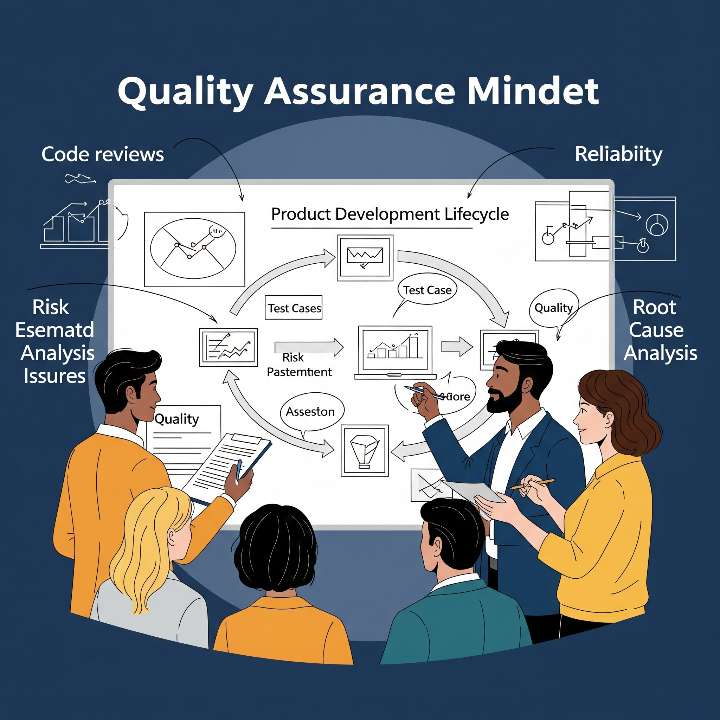 OTHERS
OTHERS QA is a Mindset, Not Just Bug Finding

The statement, "Quality Assurance is not actually finding bugs, it's a mindset," represents a fundamental and powerful shift in how we approach building high-quality products. It moves QA from a reactive, isolated activity to a proactive, integrated principle that is the shared responsibility of the entire team.
The Old View: QA as Bug Hunting (Reactive)
Traditionally, Quality Assurance was seen as the final gatekeeper in the development process. Its primary function was to inspect the finished product and find defects before it reached the customer.
- Role: A detective looking for clues (bugs) after the code has already been written.
- Goal: To find and report as many bugs as possible. Success was often measured by the quantity of bugs found.
- Timing: Occurred late in the development cycle, just before release.
- The Problem: This approach is inefficient, expensive, and often creates an adversarial relationship between developers and testers. It treats the symptoms (bugs) rather than addressing the root cause (flaws in the process, requirements, or design).
The Modern View: QA as a Mindset (Proactive)
The modern view embeds quality into every stage of the product development lifecycle. It is a culture, an attitude, and a perspective championed by QA professionals but adopted by everyone on the team. This mindset is built on several key pillars.
1. Curiosity and Critical Thinking
This is the practice of constantly asking "What if?". It goes beyond simply verifying that the software meets the written specifications; it questions the specifications themselves.
- "What if the user enters a negative number here?"
- "What if the network connection drops during this transaction?"
- "What if a user from a different culture, who reads right-to-left, uses this interface?"
- "Does this feature actually solve the user's problem in an intuitive way?"
2. Deep User Empathy
A product can be technically "bug-free" but still deliver a poor user experience. The QA mindset advocates for the user at every turn, ensuring the final product is not just functional, but also usable, intuitive, and even delightful.
- Is the workflow confusing or frustrating?
- Is the application slow or unresponsive?
- Does the feature provide genuine value to the user?
3. Proactive Prevention over Reactive Detection
The core goal of the QA mindset is to prevent defects from being introduced in the first place. This is often called "Shifting Left"—moving quality-focused activities earlier in the development process.
- Requirements Phase: Questioning and clarifying requirements to eliminate ambiguity before design begins.
- Design Phase: Reviewing wireframes and mockups to identify potential usability issues before a single line of code is written.
- Development Phase: Collaborating with developers to discuss testing strategies and potential edge cases as they are actively coding.
It is exponentially cheaper and faster to fix a flaw on a whiteboard than it is to fix it in released software.
4. A Holistic, Big-Picture View
A bug is rarely just an isolated coding error. It is often a symptom of a deeper issue. The QA mindset seeks to understand the root cause.
- Why did this bug happen? Was the requirement unclear? Was there a communication gap between teams? Did a developer lack specific domain knowledge? Was the timeline unrealistic?
- By identifying the root cause, the QA mindset helps to improve the entire process, making the team more effective and preventing entire classes of future bugs
🎯 Goal
- Bug Hunter: Finds issues in finished code.
- QA Mindset: Prevents issues across the whole lifecycle.
❓ Core Question
- Bug Hunter: “Is this broken?”
- QA Mindset: “Are we building the right thing the right way?”
🎯 Focus
- Bug Hunter: Just the code.
- QA Mindset: UX, process, design, requirements and code.
⏰ Timing
- Bug Hunter: Joins late, reacts to problems.
- QA Mindset: Involved early, prevents problems.
🐞 Bugs Seen As
- Bug Hunter: Dev's fault.
- QA Mindset: Process flaw symptom.
🏁 Success Means
- Bug Hunter: Lots of bugs caught.
- QA Mindset: Smooth, quality release with fewer bugs.
